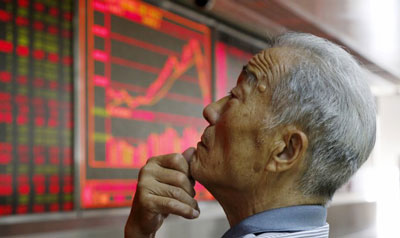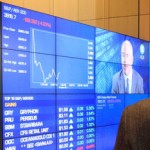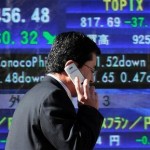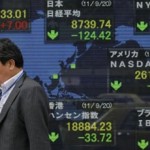Asia mixed, with Chinese markets leading the way

Chinese markets stood out in a mixed trading session in Asia on Monday, with many market watchers predicting a quiet week ahead in the absence of major economic data from the U.S. and China, and with many markets off for Good Friday.
Chinese markets traded up, with the Shanghai composite higher by 1.49 percent in afternoon trade, while the Shenzhen composite added 1.6 percent.
The South Korean Kospi gave up early gains to finish lower by 2.36 points, or 0.12 percent, at 1,989.76. Hong Kong’s Hang Seng index erased morning gains to trade down 0.1 percent.
Down Under, the ASX 200 closed down 16.52 points, or 0.32 percent, at 5,166.60, weighed by losses in the energy and financials subindexes, down 1.03 and 0.55 percent respectively.
In Japan, the benchmark Nikkei 225, which shed 1.25 percent Friday to close at 16,724.81, was closed for a public holiday. The index came under pressure late last week, following renewed strength in the Japanese yen against the dollar.
Chinese brokerages saw sharp gains, trading up over 7 percent each, with Founder Securities gaining 10 percent, Citic Securities adding 8.79 percent and Haitong Securities higher by 7.70 percent.
State-backed China Securities Finance Corporation, which provides margin financing loan services to securities companies, announced on its website last Friday it will restart offering loans to Chinese securities firms for periods ranging from 7 to 182 days, reported Bloomberg.
On Monday, data on its website showed interest charged on 7-day loans was 3.4 percent, while 182-day loans were charged 3 percent, down from 4.8 percent on Friday.
Francis Cheung, head of China and Hong Kong strategy at CLSA, told CNBC China Securities Finance’s statement was “clearly a catalyst” behind today’s rally. Cheung said investors were cautious that the Chinese national team had been supporting the market during the National People’s Congress (NPC) meeting and the “worry was that they would stop after the meetings.”
“But the NPC and the government work plan told us that the government wanted aggregate financing (stock) to go up this year by 13 [percent] and given the banks are under-pressure, that leaves the stock and bond market,” said Cheung by email, adding, “PBOC [governor] Zhou said over the weekend that corporates are overly leverage and should use more equity financing. This implies that the government wanted a stronger stock market.”
Angus Nicholson, a market analyst at spreadbetter IG, added in an afternoon note, “The Chinese government is clearly pining for the days of yore when domestic stocks and property investment both moved up in tandem.”
He added, “The stimulus taps are clearly being turned back on, despite new government efforts to rein in debt such as the new debt-equity swaps being offered to Chinese banks. The “reflationistas” and heavy spenders of Chinese politics seem to have come out the winners from China’s recent NPC.”
In the currency market, the Japanese yen maintained its strength against the dollar, with the dollar/yen pair trading near flat at 111.49 Monday afternoon, compared to Friday’s finish at 111.55. Earlier on Monday, the pair fell to a session low of 111.20.
Meanwhile, the Australian dollar weakened against the U.S. dollar Monday morning, with the pair trading down 0.18 percent at 0.7585. Last Thursday, the Aussie reached the $0.76 level against the greenback, before retreating.
Ray Attrill, global co-head of FX strategy at the National Australia Bank, said in a note that the Australian market would be “on guard for some renewed jawboning on the currency. Lack thereof will likely be a catalyst for new post July 2015 highs” in the currency market.
The Chinese yuan weakened against the dollar, with the dollar/yuanpair trading up 0.25 percent at 6.4841. Before market open, thePeople’s Bank of China (PBOC) set the yuan mid-point at 6.4824 to the dollar, compared with Friday’s fix of 6.4628.
The dollar index, which measures the U.S. dollar against a basket of currencies, was near flat at 95.12.
Hong Kong-listed shares of Standard Chartered bank surged Monday, gaining 7.84 percent, following gains in the bank’s shares in London trading on Friday. A spokesperson from Standard Chartered in Hong Kong told CNBC by email, “We have not made any material or price-sensitive share price announcement over last two days.”
Major Australian miners closed mixed, with shares of Rio Tinto down 0.11 percent and BHP Billiton adding 0.39 percent. The country’s so-called Big Four banks – ANZ, Commonwealth Bank of Australia,Westpac and NAB – ended the trading day lower between 0.49 and 1.31 percent.
In corporate news, the Australian Securities Exchange (ASX) announced after market close its managing director and chief executive, Elmer Funke Kupper, has resigned with immediate effect. In a media release, ASX chairman, Rick Holliday-Smith, said, “We have an experienced senior executive team who will work with me to manage the business while we search for a new CEO.”
South Korean blue chip stocks ended mixed, with Samsung Electronicserasing early gains to close lower by 0.47 percent, Kepco up 0.84 percent and Hyundai Motor higher by 2.66 percent.
Oil prices retreated during Asian hours, with U.S. crude futures lower by 1.42 percent at $38.88 a barrel, while global benchmark Brent was down 0.70 percent at $40.91.
Energy plays in Asia were mixed, with Santos closing down 2.96 percent and Woodside Petroleum erasing losses to close up 0.33 percent, while mainland shares of China’s Sinopec up 1.83 percent.
Gordon Gray, global head of oil and gas research at HSBC Bank, and Thomas Hilboldt, head of resources and energy research for Asia Pacific at HBSC, wrote in a Monday note oil prices around current levels are “unsustainable in the longer term.”
“We cannot rule out a near-term price correction after the recent rally, but view a return to the low levels of early 2016 as highly unlikely,” they said, adding, “In our view the rally has been driven by a number of factors: demand has been holding up well, and estimates of 2016 non-OPEC output are continuing to decline.”
Major U.S. indexes closed in the green on Friday, with the Dow Jones industrial average up by 0.69 percent, S&P 500 higher by 0.44 percent and the Nasdaq composite ending 0.43 percent higher.
Source: CNBC




























